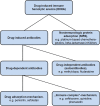Ceftriaxone-induced hemolytic anemia with severe renal failure: a case report and review of literature
- PMID: 30359322
- PMCID: PMC6203207
- DOI: 10.1186/s40360-018-0257-7
Ceftriaxone-induced hemolytic anemia with severe renal failure: a case report and review of literature
Abstract
Background: Drug induced immune hemolytic anemia (DIIHA) is a rare complication and often underdiagnosed. DIIHA is frequently associated with a bad outcome, including organ failure and even death. For the last decades, ceftriaxone has been one of the most common drugs causing DIIHA, and ceftriaxone-induced immune hemolytic anemia (IHA) has especially been reported to cause severe complications and fatal outcomes.
Case presentation: A 76-year-old male patient was treated with ceftriaxone for cholangitis. Short time after antibiotic exposure the patient was referred to intensive care unit due to cardiopulmonary instability. Hemolysis was observed on laboratory testing and the patient developed severe renal failure with a need for hemodialysis for 2 weeks. Medical history revealed that the patient had been previously exposed to ceftriaxone less than 3 weeks before with subsequent hemolytic reaction. Further causes for hemolytic anemia were excluded and drug-induced immune hemolytic (DIIHA) anemia to ceftriaxone could be confirmed.
Conclusions: The case demonstrates the severity of ceftriaxone-induced immune hemolytic anemia, a rare, but immediately life-threatening condition of a frequently used antibiotic in clinical practice. Early and correct diagnosis of DIIHA is crucial, as immediate withdrawal of the causative drug is essential for the patient prognosis. Thus, awareness for this complication must be raised among treating physicians.
Keywords: Ceftriaxone; Drug-induced immune hemolytic anemia; Hemolysis.
Conflict of interest statement
Ethics approval and consent to participate
Not applicable.
Consent for publication
Written informed consent from the patient for this case report was obtained.
Competing interests
The authors declare that they have no competing interests.
Publisher’s Note
Springer Nature remains neutral with regard to jurisdictional claims in published maps and institutional affiliations.
Figures



References
-
- Arndt PA. Drug-induced immune hemolytic anemia: the last 30 years of changes. Immunohematology. 2014;30:44–54. - PubMed
-
- Garratty G, Arndt PA. Drugs that have been shown to cause drug-induced immune hemolytic anemia or positive direct antiglobulin tests: some interesting findings since 2007. Immunohematology. 2014;30:66–79. - PubMed
Publication types
MeSH terms
Substances
LinkOut - more resources
Full Text Sources
Medical
Research Materials

